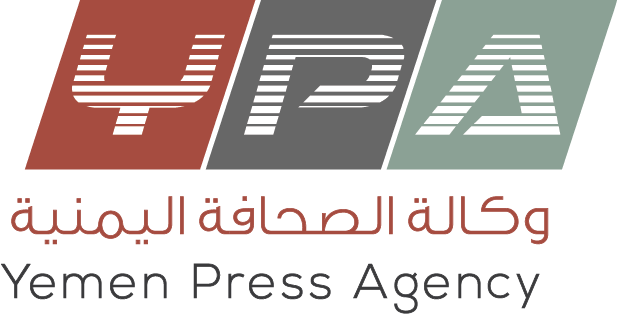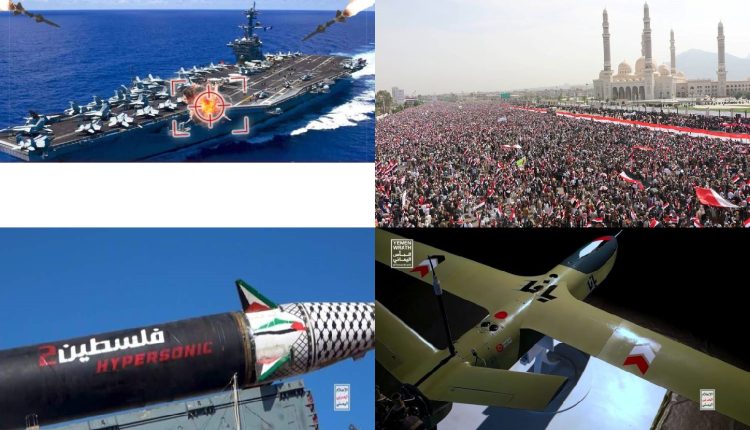Two years of support, Sanaa imposes economic isolation on Israeli occupation and media “demonization” machine fails!
SANAA, Oct. 11 (YPA) – The Sanaa authorities continue to assert their active and influential presence in the regional conflict equations through a steady stream of military and naval support, culminating in massive million-person marches in the capital, Sanaa, and others governorates. They announced two years of continuous support for Gaza under the slogan “The Flood of Al-Aqsa…Two Years of Jihad and Sacrifice Until Victory.” This support was not limited to being a political position, but was translated into practical measures that imposed clear economic isolation on the Israeli entity and its supporters, and undermined a large part of the credibility of the Western media machine.
Million-Person Marches
The capital, Sanaa, and other governorates witnessed million-man demonstrations yesterday, Friday, which represented a firm affirmation of the steadfast Yemeni position in support of Gaza, revealing a moral and strategic choice stemming from a liberated national will after the September 21 Revolution, and consistent with the paths and developments of current events. The marches’ statement opened by praising the steadfastness of the Palestinian people and the valiant resistance in Gaza, stressing that this steadfastness proved the failure of the aggression, as the Israeli entity did not succeed in achieving its declared goals since the start of the “Al-Aqsa Flood,” noting that the steadfastness of the resistance and the unity of the Palestinian people have led to the impotence and impasse of the occupation authorities and their American backer, which revealed the fragility of the aggressive project.
In addition, the participants renewed their pledge of loyalty to the leadership, and the marches blessed the positions of the axis of resistance, represented by Hezbollah, the Iraqi resistance, and the Islamic Republic of Iran, considering them essential pillars of steadfastness in confronting the Zionist-American project. The statement concluded by emphasizing preparedness and warning, affirming the constant readiness for comprehensive action in the face of any escalation by the Israeli or American entity, which reflects Yemen’s transformation into an effective force capable of making a practical contribution to the conflict equations. The statement also directed harsh criticism at the Arab regimes, which were described as conspiring or treasonous.
Paralysis of the Port of Eilat and a Global Insurance Crisis
In a related context, the Sanaa authorities continue their military and naval support, imposing a comprehensive naval blockade on Israeli ships and vessels operating in its ports. This effectively means a clear failure of all protection attempts led by the United States and its allies. The facts confirm that ships subject to the targeting rules imposed by the Sanaa authorities do not escape their fire, the most recent of which was the qualitative operation that targeted the ship “Minerva Karat” in the Gulf of Aden for violating the decision to ban entry to the ports of occupied Palestine, after targeting the ships “Magic Seas” and “Eternity C.”
The naval operations have radically transformed global trade routes and imposed a direct and increasing economic burden on the Israeli entity, as shipping prices have doubled and insurance premiums have risen to an unprecedented level, discouraging international companies from dealing with the occupied ports. Reports indicate a near-complete halt in the occupied southern ports, especially the port of Eilat, which has become almost bankrupt, according to the Asia Times.
The impact of the ban has extended to include the occupation’s allies, as the American website Oil Price revealed that marine shipping insurance companies have begun imposing additional fees on ships linked to American and British companies, reaching 50% in war risk premiums for sailing in the Red Sea. Some companies have also begun refusing to deal with these ships, which is expected to incur heavy losses for the American and British economies and lead to higher prices. This confirmation of the accuracy of Yemeni targeting came from the global head of marine services at Marsh Insurance Company, who told Reuters that the ships that encountered problems are almost all linked to Israeli, American, or British ownership elements, confirming the accuracy of Yemeni intelligence.
American Stress and Flight of Investments
The effectiveness of the operations was not limited to the economic aspect; it extended to revealing the failure of American protection and the Israeli occupation army. Military analysts acknowledged that the targeting was characterized by “precision in handling data and information” and professionalism, stressing that the Yemenis are carrying out their threats with vigor.
In an implicit acknowledgment of the effectiveness of the operations, the Hebrew newspaper Yedioth Ahronoth revealed that the Israeli occupation army had established two new intelligence units to monitor “the growing threat posed by the Yemeni armed forces, acknowledging a qualitative shift” in the defensive and offensive capabilities of the Sanaa authorities, particularly in the areas of local manufacturing of missiles and drones.
The American newspaper Business Insider discussed the impact of the operations on the US Navy, noting that they created a “steep learning curve” and forced it to review its combat doctrine and ammunition management strategies, shifting its focus to less expensive munitions instead of expensive missiles such as the SM-6 and SM-2, whose stockpiles had been depleted. This confirms that Yemen has succeeded in imposing a low-cost deterrence equation that has confounded the US Navy.
Deep inside “Israel”, Yemeni military operations have continued, with the settlements witnessing almost daily attacks by hypersonic missiles and Yemeni drones, in a clear indication of the inability of Zionist and Western defense systems. Military experts such as Brigadier General Abdul Ghani Al-Zubaidi have confirmed that Yemen possesses “a vast and sensitive target bank for the Zionist enemy,” and that operations will not stop until the aggression stops and the siege on the Gaza Strip is lifted. He pointed out that Yemeni military capabilities have become a major challenge to the Zionist enemy, the United States, and its allies. Military expert Brigadier General Abed Al-Thawr also indicated that “Yemeni technology represents a major challenge to both American and Israeli technology.”
Economic Isolation and Erosion of Western Credibility
The ongoing Yemeni operations, coupled with the ongoing war on Gaza, have prompted businessmen and the wealthy to flee and withdraw investments from Israel in the absence of a safe investment environment. The 2024 Private Wealth Migration Report, issued by Henley & Partners, showed that more wealthy emigrants are leaving the entity than those insisting on staying, a significant departure from its previous position as a destination for millionaires. The occupation crisis deepened with the intensification of the blockade, with the port of Haifa now included within the maritime embargo zone, in addition to the crisis at Lod Airport, known in Israel as Ben Gurion Airport, as a result of the continued suspension of flights by numerous airlines.
This support did not limit its impact to the military and economic fronts; rather, the effectiveness of operational coordination between the support fronts of Yemen, Lebanon, and Iraq led to easing field pressure on Gaza by imposing a forced distribution of the Israeli occupation army’s military resources.
In contrast to this effectiveness, the Western media machine failed to demonize these movements, as the excessive focus on the threat to navigation and the disregard for the scale of the genocide in Gaza eroded the credibility of this media and revealed Western moral duplicity, which pushed the public to search for alternative sources of information and made the popular movement in solidarity with Palestine in the West and the Global South deep.
In conclusion, field developments and military analyses confirm that the Sanaa authorities continue to manufacture a historic position in support of Gaza, and that the Yemeni operations do not represent only a symbolic blow, but also force the Israeli entity to review its protection system and commercial and operational flow, which doubles the burdens on the war economy and undermines the margin of maneuver. They prove that jihad and patience are the path to thwarting aggression plans, and that the Zionist entity is weaker than a spider’s web.
Th.S.


